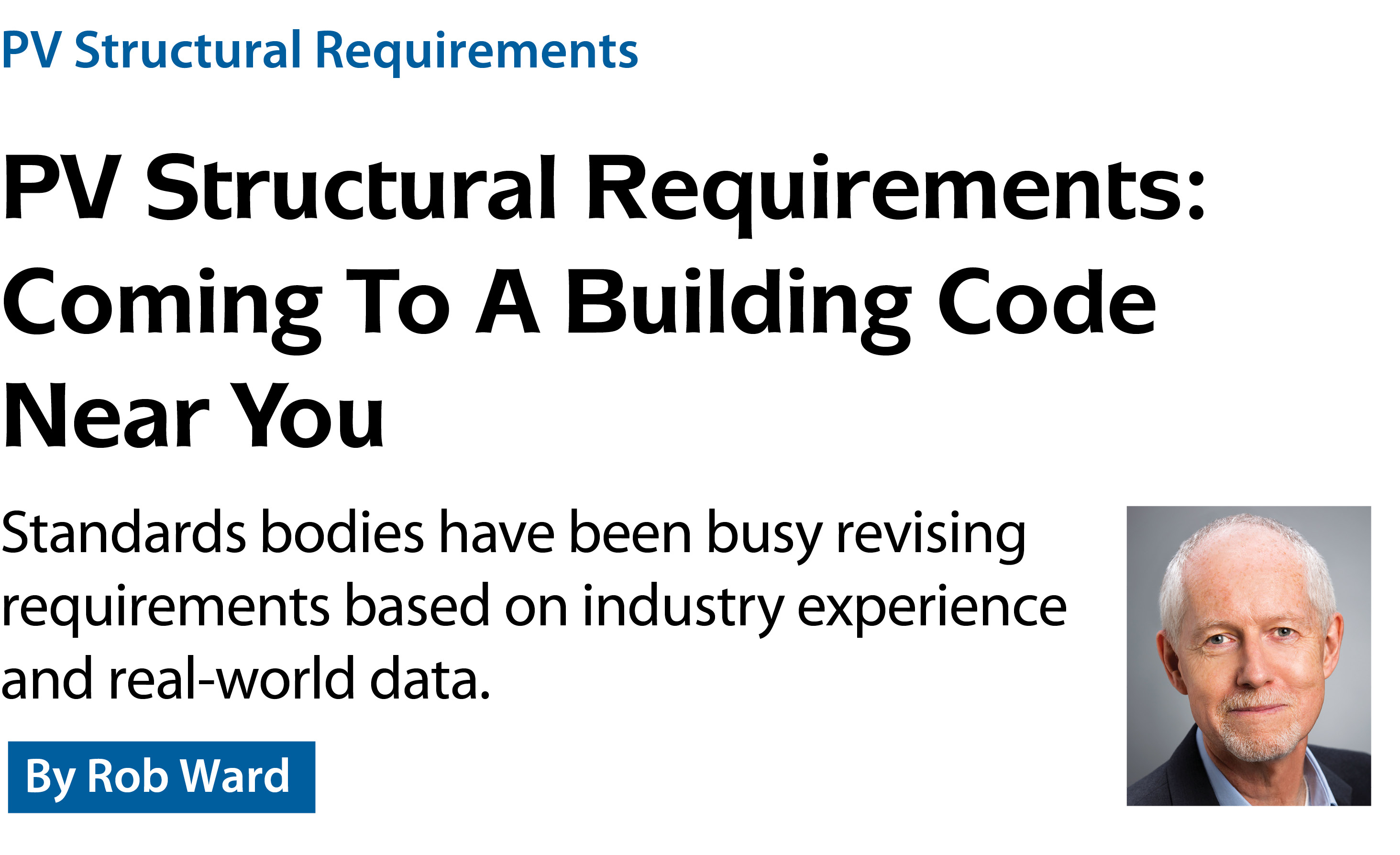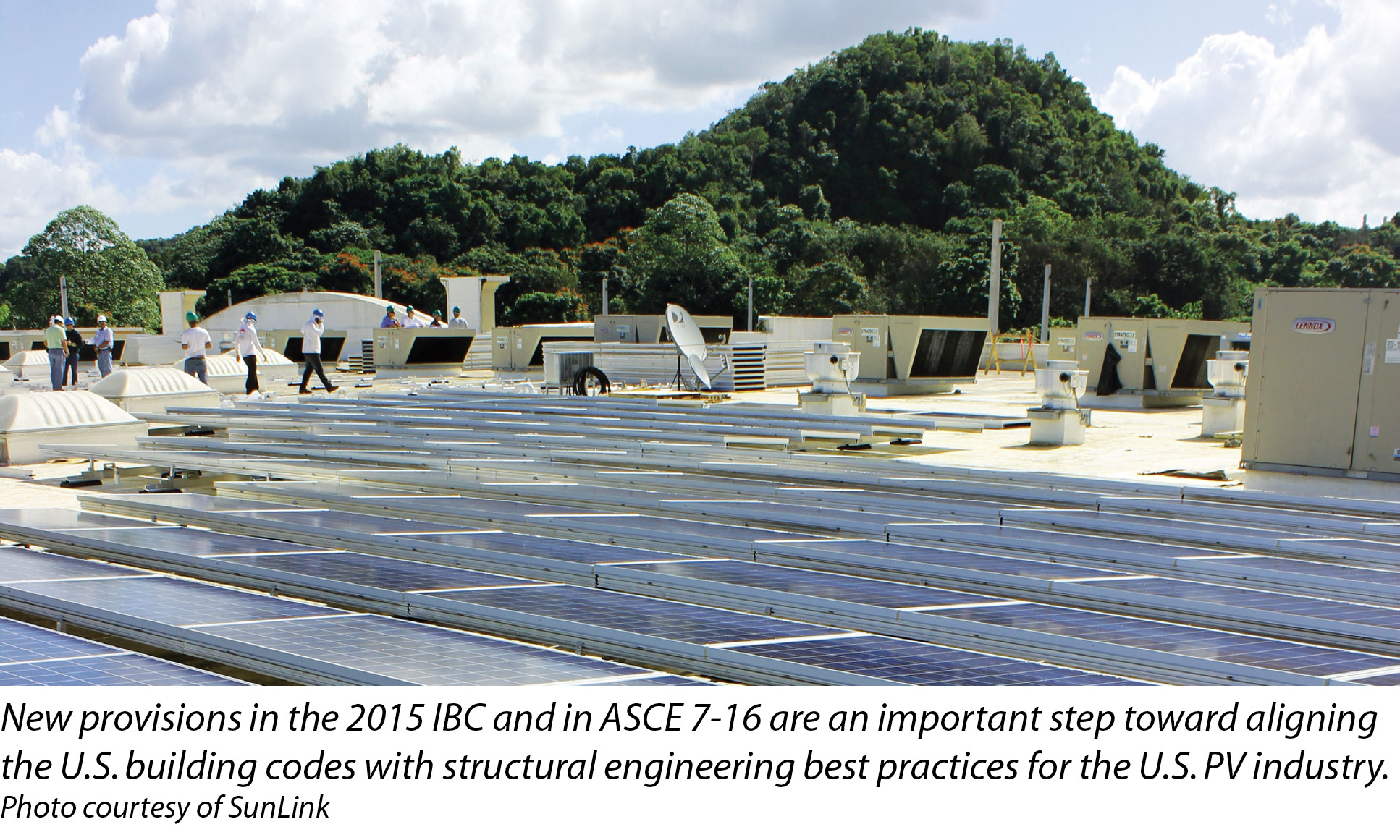

301 Moved Permanently
Few would disagree that structural engineering plays an important part in any well-designed solar photovoltaic system, yet structural engineers find very little specific guidance for PV system design in the current U.S. building codes.
At first glance, this may seem strange, given that adequate structural strength is important in fulfilling a key building code objective: protecting the safety and welfare of the public. Look a little further, though, and it becomes evident that the growth of the PV industry over the last several years has simply outpaced code development.
The writers of the U.S. building codes have been working to catch up, and the most recent editions of two main documents that serve as the foundation of almost all U.S. building codes include new structural requirements for PV systems. A look at these documents provides a sneak peek at what we are likely to see in the next iteration of the building codes themselves.
The 2015 International Building Code
The International Building Code (IBC), a consensus document published triennially by the International Code Council, contains the model code language that is adopted by the vast majority of building departments across the U.S. Most building codes in force today are based on the 2012 edition of the IBC, though a significant number remain based on earlier editions.
Adoption of the 2015 edition, published in May 2014, is now beginning; New Jersey and Maryland have adopted it statewide, and it has been approved in South Dakota for local adoption. The 2015 IBC will continue to become the basis for most state codes, such as the upcoming 2016 California Building Code. The 2015 IBC is the first edition to contain structural provisions specifically for PV systems. It contains new requirements for roof loads and the seismic design of ballasted rooftop arrays - as in the following:
Design roof loads. In structural engineering, “live loads” are caused by the weight of people and things that can be moved around, while “dead loads” are caused by the weight of permanently installed equipment and the self-weight of a building. Building codes require that unoccupied roofs be designed to accommodate some live loads, such as those that are required for maintenance work, re-roofing work and emergency responders.
Though it is clear that installing a PV array on an existing roof increases the amount of dead load the roof carries, what has been less certain is whether a roof still requires the same live load capacity in areas that are covered by PV modules. Similarly, there has been no guidance for cases in which the PV modules are actually the roof covering itself, such as on a carport structure. The 2015 IBC Section 1607.12.5 now provides requirements that directly address these concerns.

Ballasted, non-penetrating, roof-mounted PV systems and earthquakes. Earlier versions of the IBC require that in moderate- to high-seismic hazard zones, almost all permanent equipment in or on a building must be fastened to the building. Several years ago, proprietary research by some California PV mounting system manufacturers and their structural engineering consultants showed that because of the nature of PV arrays - low and distributed - and their locations, ballasted arrays on low-slope roofs could be designed for safe earthquake performance by quantifying the distance they could shift and then designing for that shift.
SunLink, together with Rutherford + Chekene, developed and published a similar displacement-based methodology that was verified in 2012 by full-scale shake table testing at the Pacific Earthquake Engineering Research Center at the University of California, Berkeley. The tests were underwritten, in part, by the California Public Utilities Commission. Using this research to inform its work, the newly formed Structural Engineers Association of California (SEAOC) PV Systems Committee published guidelines for this approach in its document number PV1-2012, entitled “Structural Seismic Requirements and Commentary for Rooftop Solar Photovoltaic Arrays.”
SEAOC’s PV1 document, in turn, served as the basis for new provisions in the 2015 IBC. Section 1613.6 of the 2015 IBC allows a displacement-based seismic design approach to be used for ballasted, non-penetrating (unattached) rooftop arrays when a few conditions are met, though it provides few specifics on the implementation of this approach. Section 1613.6 has also been adopted into several codes that are still based on the 2012 IBC - namely the 2013 California Building Code for some state agency jurisdictions and the 2014 Oregon Structural Specialty Code.
As states with high- to moderate-seismic zones follow New Jersey and Maryland’s lead and adopt the 2015 IBC’s model code language, this displacement-based approach will become a generally adopted code approach.

ASCE 7-16
The building design loads U.S. structural engineers use are specified in “Minimum Design Loads for Buildings and Other Structures,” a standard document that is included in the IBC by reference. It is currently published every six years by the American Society of Civil Engineers (ASCE). This design load standard is commonly referred to as Standard Number 7, and its next edition, ASCE 7-16, is expected in March 2016, or shortly thereafter.
Newly published research is allowing ASCE 7-16 to be the first edition of this standard to consider some of the unique aspects of PV systems, and it will contain a number of important provisions for PV project designers. Considering current code development cycles, ASCE 7-16 will be referenced in the 2018 IBC, and then that document will become widely adopted at the state and local levels by early 2020.
Although this official adoption may seem a long way off, engineers and building officials could use ASCE 7-16 provisions as a basis for an accepted alternate means of code compliance as soon as the document is published.
There are several new provisions in ASCE 7-16 that apply to PV systems or will be of particular interest to engineers designing PV systems - as in the following:
Flush-mount arrays on sloped roofs. ASCE 7-16 contains a new method for calculating the wind loads on flush-mounted arrays that accounts for the pressure-equalizing effect caused by air gaps around and underneath the modules.
Tilted arrays on low-slope roofs. In 2012, the SEAOC PV Systems Committee published Guideline PV2, entitled “Wind Design for Low-Profile Solar Photovoltaic Arrays on Flat Roofs.” This document contains charts and equations for determining wind loads for open, tilted arrays on low-slope roofs. A simplified and slightly modified version of the PV2 method is contained in ASCE 7-16.
Ballasted systems and earthquakes. As mentioned previously, Section 1613.6 in the 2015 IBC contains provisions for a displacement-based approach to the design of ballasted rooftop arrays in moderate- to high-seismic zones, but it does not provide many details.
Structural engineers can look to SEAOC PV Systems Committee Guideline PV1-2012, “Structural Seismic Requirements and Commentary for Rooftop Solar Photovoltaic Arrays,” for some recommended specifics, but this is not a code document. ASCE 7-16 brings the details of this displacement-based approach into the code. These new seismic provisions for ballasted arrays are similar to SEAOC PV1, but there are important differences; the ASCE 7-16 provisions are somewhat more conservative than the SEAOC PV1 recommendations.
New wind speed maps. PV array designers will note immediately that the design wind speed maps in ASCE 7-16 have been updated. An additional decade or more of wind data has become available since the last update to the design wind speed maps for U.S. regions away from the hurricane coastlines, and this new data has enabled the creation of wind speed maps with greater resolution. New data has also reduced the degree of conservatism and led to design wind speeds that are lower for much of the U.S.
The new maps are not specific to PV arrays, of course, but they will have a significant impact on PV array wind loads in many parts of the U.S.
Wind tunnel testing. Starting in the 1960s, atmospheric boundary layer wind tunnel testing was used to determine the design of wind pressures on important, unusually shaped buildings and other wind-sensitive structures, such as bridges. Basic rules for this type of wind tunnel study are found in ASCE 7-10 and earlier editions.
Atmospheric boundary layer wind tunnel testing is now also commonly used to determine wind coefficients for tilted, low-slope rooftop PV arrays in order to evaluate the aerodynamic features used to reduce the wind loads on the array. Requirements for this type of testing, which differ from those for testing specific buildings and bridges, are now also provided in ASCE 7-16.
Because well-designed aerodynamic features - such as shrouds, gaps and geometry - can greatly reduce the lift and drag loads on an array, ASCE 7-16 also lists requirements for providing expert peer reviews of wind tunnel studies with results that are much lower than open, tilted systems.
Dynamic sensitivity. Wind is turbulent because of its interaction with the objects it flows over and around, and PV array mounting systems can be sensitive to the dynamic effects of that turbulence. ASCE 7-16 amends the long-standing 1 hertz fundamental frequency limit for dynamically sensitive structures so that it is now only the limit for buildings. This is because buildings are of a scale for which 1 hertz is an appropriate limit, but smaller structures, such as PV arrays, can be sensitive to the smaller-scale, higher-frequency turbulence that can occur when wind blows across an array field.
In order to properly address smaller structures, such as ground-mounted PV arrays, ASCE 7-16 now requires that the fundamental vibrational frequency dynamic sensitivity limit for other structures be appropriate for the size of those structures.
What’s next?
These new provisions in the 2015 IBC and in ASCE 7-16 are an important step toward aligning the U.S. building codes with structural engineering best practices for the U.S. PV industry. There is more to do, though, as we pursue the ultimate goal of ensuring that the structural aspects of PV array installations provide code-level safety and performance.
The SEAOC PV Systems Committee is continuing to look at structural engineering issues related to PV installations and is working toward the publication of new and updated guidelines. Topics currently being addressed include testing procedures, roof capacity and roof loads, wind uplift load sharing, and wind dynamic effects. The committee’s goal continues to be bringing forward best practices that lead to the best structural solutions for PV projects.
PV Structural Requirements
PV Structural Requirements: Coming To A Building Code Near You
By Rob Ward
Standards bodies have been busy revising requirements based on industry experience and real-world data.
si body si body i si body bi si body b
si depbio
- si bullets
si sh
si subhead
pullquote
si first graph
si sh no rule
si last graph